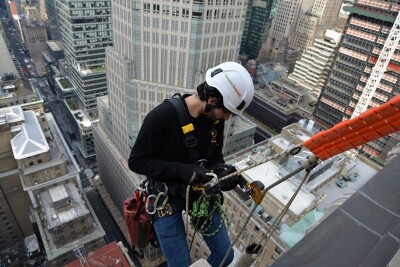As a professional flight safety organization for operators, enterprises, and organizations focused on integrating and operating UAS safely for civil or commercial purposes, the Unmanned Safety Institute works around the world to delivering award-winning UAS flight safety training and drone certification programs. As part of their efforts to educate the community, USI has previously detailed essential insights around adopting drones for business and also explained what it means to be safe when flying a drone.

Josh Olds
To explore how these topics and others will further evolve for commercial drone operators in 2019, we connected with Josh Olds, President and Co-Founder of the Unmanned Safety Institute. He's a member of the FAA’s Unmanned Aircraft Safety Team (UAST) and is also a member of the advisory board for the Energy Drone Coalition. Josh is a FAA licensed commercial pilot and certified A&P Mechanic and has served in a variety of UAS operational roles operating and maintaining both fixed wing and rotorcraft Unmanned Aircraft Systems. This background has provided him with essential insight around what 2019 has in store for the drone industry as a whole.
Jeremiah Karpowicz: How do you think the stance and approach around education and training for drones and drone operations will evolve in 2019?Josh Olds: I see a significant trend in organizations moving toward standardized education and training across organizational business units, whereas the remote pilot certificate is a general requirement, but aviation-based safety based education and skill-based training are the primary requirements of remote pilots within the organization.
For many, Part 107 has opened the doors for training crews that had no prior experience in aviation or unmanned technology, so utilizing a balanced aviation-based safety education and training program has allowed employees to utilize drone technology as a tool but also as professional remote pilots in the national airspace. As waivers from Part 107 continue to increase, I see education and training that have primarily revolved around Part 107 requirements shifting to provide a better foundation for more scale and complex operations and for more complex aircraft that are driven by these programs of higher standards.
Two years ago the thought of education and training around this technology was bizarre to some as the technology and automation have taken many of the pilot operational requirements out of the loop. This being said, there has been a mindset shift that even with technology that is easy to fly, there are still judgment calls and planning decisions that need basic aviation safety practices and a currency and proficiency-based flight training program to maintain skillsets and informed aeronautical decision making. This is not very different than other industry skillset requirements.
Where do you think the greatest opportunities reside for individual operators as well as large organizations that want to trigger business transformations with drones in 2019?The last two years of Part 107 has provided individuals and organizations an opportunity to find best use cases for VLOS technology to make current operations safer or even return efficiencies and value to the organization. As we turn the corner into 2019 there are significant opportunities that are present in the more complex operations and complex UAS aspect of the industry with BVLOS, aircraft greater than 55lbs, operations over people, more payload, redundant systems, etc.
To further enable these opportunities, I encourage an open dialog between the business units/departments of someone’s organization as management of the technology and opportunity requires collaboration. The most successful companies deploying unmanned technology, have teams that can coordinate and create efficiencies across departments (i.e. Information Technology, Flight Department, Compliance/Risk Management, Environmental Health and Safety, Operations, etc.).
What are you personally looking forward to seeing happen/develop in the commercial drone space in 2019? The greatest opportunities for unmanned technology are stifled by lack of knowledge of the technology, time-honored aviation safety practices, and maintenance solutions ensuring airworthiness of aircraft systems. Opportunities turn into successful endeavors when the right foundational programs support the framework for success. As exciting as the technology is and the opportunities that are present, the seriousness of the endeavor of incorporating unmanned aircraft into a business and the national airspace requires organizational standards, structure, processes and procedures as VLOS operations are just the beginning.
To trigger business transformations for incredible opportunity and more so success in those opportunities, I am personally looking forward to seeing organizations establish and adopt foundations from which technology and aviation merge for a modern aviation solution.
What’s going to be a bigger topic in 2019: the autonomous capabilities of drones, data security or counter-drone technology? Counter-Drone technology is going to play a large role in 2019. It is hard to ignore the situation at Gatwick as this has been a concern since the earlier portion of this decade for airports and large event venues.

















Comments